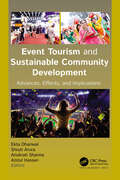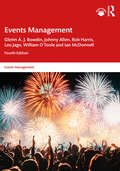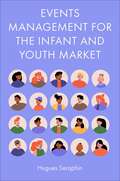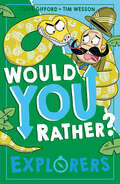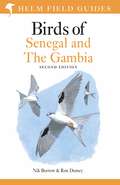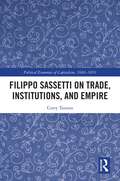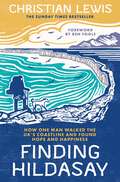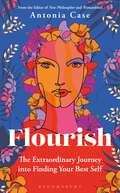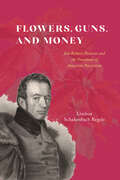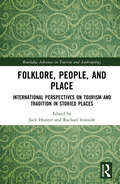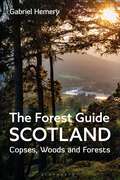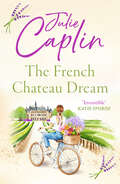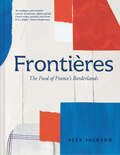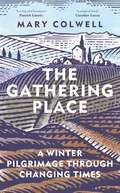- Table View
- List View
Event Tourism and Sustainable Community Development: Advances, Effects, and Implications
The event tourism business has become more and more essential to community development in countries around the world, helping to increase the appeal of specific destinations and generating huge economic benefits for the communities of the destinations, impacting local economies. With examples from India, Sri Lanka, Turkey, Malaysia, United Arab Emirates, Bangladesh, Cambodia, Portugal, Argentina, and Zimbabwe, this volume provides a valuable examination of sustainable community development in conjunction with event tourism along with helpful tools for promoting, organizing, and hosting successful events. This book looks at a wide range of festivals and other events around the world and examines their impact on tourism, sustainability, local culture and community, and community development. It highlights rural as well as urban event tourism, event tourism during and after COVID–19, how event tourism impacts women’s empowerment, promoting event tourism and community development, new opportunities and challenges in event tourism education, and more.
Events Management (Events Management)
by Glenn A. Bowdin Johnny Allen Rob Harris Leo Jago William O'Toole Ian McDonnellA must-have introductory text of unrivalled coverage and depth focusing on events planning and management, the fourth edition of Events Management provides a complete A to Z of the principles and practices of planning, managing and staging events. The book offers a systematic guide to organising successful events, examining areas such as event design, logistics, marketing, human resource management, financial planning, risk management, impacts, evaluation and reporting. The fourth edition has been fully updated and revised to include content covering technology, including virtual and hybrid events, concepts such as social capital, soft power and events, social inclusion, equality, accessibility and diversity, and the latest industry reports, research and legal frameworks. The book is logically structured and features new case studies, showing real-life applications and highlighting issues with planning events of all types and scales in a range of geographical locations. This book has been dubbed ‘the events management bible’ and fosters an interactive learning experience amongst scholars of events management, tourism and hospitality.
Events Management (Events Management)
by Glenn A. Bowdin Johnny Allen Rob Harris Leo Jago William O'Toole Ian McDonnellA must-have introductory text of unrivalled coverage and depth focusing on events planning and management, the fourth edition of Events Management provides a complete A to Z of the principles and practices of planning, managing and staging events. The book offers a systematic guide to organising successful events, examining areas such as event design, logistics, marketing, human resource management, financial planning, risk management, impacts, evaluation and reporting. The fourth edition has been fully updated and revised to include content covering technology, including virtual and hybrid events, concepts such as social capital, soft power and events, social inclusion, equality, accessibility and diversity, and the latest industry reports, research and legal frameworks. The book is logically structured and features new case studies, showing real-life applications and highlighting issues with planning events of all types and scales in a range of geographical locations. This book has been dubbed ‘the events management bible’ and fosters an interactive learning experience amongst scholars of events management, tourism and hospitality.
Events Management for the Infant and Youth Market
by Hugues SeraphinInfants and young adults represent the future of the events industry. Yet, until now, there has been little research in this important and growing sector. Events Management for the Infant and Youth Market takes a comprehensive look at the unique challenges posed for planning and delivering events for young people. Bringing together practitioners and academics in unparalleled partnership, ground-breaking research is presented on event design and type in Europe, America, Asia, and Australia. The focus is on real-world application of ideas formed from empirical data. Topics include: the ‘greening’ of events, factors affecting attendance, satisfaction, and the loyalty of customers, plus a detailed cross-section and analysis of stakeholders. Four types of events are covered, business, family, sports, and cultural. The scale of events encompass local community gatherings, business events, and private functions. Practical guidelines are given for the planning and delivering of these events successfully for infants and young adults. This is the future of events, as seen by leading experts and professionals.
Events Management for the Infant and Youth Market
by Hugues SeraphinInfants and young adults represent the future of the events industry. Yet, until now, there has been little research in this important and growing sector. Events Management for the Infant and Youth Market takes a comprehensive look at the unique challenges posed for planning and delivering events for young people. Bringing together practitioners and academics in unparalleled partnership, ground-breaking research is presented on event design and type in Europe, America, Asia, and Australia. The focus is on real-world application of ideas formed from empirical data. Topics include: the ‘greening’ of events, factors affecting attendance, satisfaction, and the loyalty of customers, plus a detailed cross-section and analysis of stakeholders. Four types of events are covered, business, family, sports, and cultural. The scale of events encompass local community gatherings, business events, and private functions. Practical guidelines are given for the planning and delivering of these events successfully for infants and young adults. This is the future of events, as seen by leading experts and professionals.
The Explorer and the Journalist: Frederick Cook, Philip Gibbs and the Scandal that Shocked the World
by Richard EvansOn 1 September 1909, a telegram from American explorer Frederick Cook caused perhaps the biggest sensation in polar exploration history. With no word from Cook for over a year and many assuming he was dead, here came the news that not only had he survived his Arctic expedition, but he had claimed one of the great prizes in exploration by becoming the first person to reach the North Pole.Cook was instantly transformed into one of the heroes of the age. And with his boat due to arrive in Copenhagen a few days later, the world’s journalists scrambled to get there in time to meet him. One of those journalists was Philip Gibbs, a young reporter for the Daily Chronicle in London, who had a chance encounter in a Copenhagen café that led to him getting an exclusive interview with Cook before he reached land. But Gibbs left the interview doubting Cook’s story, and so in his subsequent article he decided to gamble both his career and his reputation by making it clear he thought Cook might be lying.Gibbs’s article made him the most unpopular man in Copenhagen, and marked the start of a frantic six days during which Copenhagen showered Cook with accolades while Gibbs tried to prove his claim was untrue. The Explorer and the Journalist is the story of the explorer who was determined to prove he really had reached the Pole, and the journalist who was convinced he was a fraud. It was a confrontation from which only one of them would emerge with his reputation intact…
Explorers (Would You Rather? #4)
by Clive GiffordWould you rather ride a hot-air balloon to the North Pole or cycle to the South Pole? Go to the toilet inside your spacecraft, or outside it? Only you can decide!
Family Businesses in Tourism and Hospitality: Innovative Studies and Approaches (Tourism, Hospitality & Event Management)
by Marco ValeriThis book provides a comprehensive collection of new insights into traditional paradigms, approaches, and methods, as well as more recent developments in issues related to family businesses in tourism and hospitality. The aim of the chapters is to verify whether, in the tourism industry, the “family business model” is an important development opportunity and, in particular, if it is an innovation driver, for this industry development. In this context, the authors contribute chapters from a diverse set of countries to investigate personal and family needs and preferences alongside the relationship between family business model, growth and profit maximization, and the development of tourism businesses through innovation drivers. SME competency, the impact of COVID-19 on performance and marketing, and policy improvements are also discussed in this volume.
Field Guide to Birds of Senegal and The Gambia: Second Edition (Helm Field Guides)
by Nik Borrow Ron DemeyThis comprehensive and fully updated edition of Birds of Senegal and The Gambia is the ultimate guide for travellers and birdwatchers visiting one of Africa's richest birdwatching regions. The Gambia, together with the country that envelops it, Senegal, has an avifauna of more than 700 regularly occurring species, including many Western Palearctic migrants from September to April, and a significant list of highly sought-after resident West African birds, including the Egyptian Plover. This authoritative guide covers all species, including details of all residents, migrants and known vagrants. Senegal and The Gambia offer a true wealth of birdlife, including a fantastic selection of Sahel specialities that are far more easily seen here than anywhere else. Senegal has become a reliable locality for Golden Nightjar, Quail-plover and Cricket Warbler, and the near-endemic Mali Firefinch occurs in the southeast of the country. Birdwatchers in this region can also find Savile's Bustard, Adamawa Turtle Dove, Little Grey Woodpecker, Yellow Penduline Tit, Sudan Golden Sparrow and Exclamatory Paradise Whydah, while the Saloum delta's huge roost of tens of thousands of African Swallow-tailed Kites is one of the world's top birding spectacles. More than 140 stunning colour plates depict every species and also comprehensively cover all the distinct plumages and subspecies likely to be encountered. Concise species accounts describe key identification features, status, range, habitat and voice, with fully updated distribution maps for each species. This compact guide is an essential companion for any birder visiting this rich and varied area of Western Africa.
Filippo Sassetti on Trade, Institutions and Empire (Political Economies of Capitalism, 1600-1850)
by Corey TazzaraThe Florentine traveler, merchant, and academician Filippo Sassetti was one of the premier economic thinkers of the late Renaissance. Well known for his ethnographic observations, Sassetti was also a commercial writer of the highest caliber—at once an original thinker and a remarkable witness to how Europeans even at the margins of empire were beginning to reconceptualize power and wealth. Unique among commercial theorists of the period, Sassetti offers a first-hand perspective on commerce in both the Mediterranean and the Indian Ocean. This volume translates (for the first time) the Discourse on Mediterranean Trade and a selection of the principal Indian Letters, with extensive historical notes. These are preceded by a lengthy essay positioning Sassetti as a figure in late Renaissance political economy. It makes the case that Sassetti was an early theorist of what might be termed the pragmatic tradition of free trade—in his case, a project linked to his analysis of commercial institutions in the Mediterranean and the Indian Ocean. Provoking an invaluable overview of trade in the Indian Ocean in the late sixteenth century, this volume is an excellent specialist text for postgraduate students and professional historians.
Filippo Sassetti on Trade, Institutions and Empire (Political Economies of Capitalism, 1600-1850)
by Corey TazzaraThe Florentine traveler, merchant, and academician Filippo Sassetti was one of the premier economic thinkers of the late Renaissance. Well known for his ethnographic observations, Sassetti was also a commercial writer of the highest caliber—at once an original thinker and a remarkable witness to how Europeans even at the margins of empire were beginning to reconceptualize power and wealth. Unique among commercial theorists of the period, Sassetti offers a first-hand perspective on commerce in both the Mediterranean and the Indian Ocean. This volume translates (for the first time) the Discourse on Mediterranean Trade and a selection of the principal Indian Letters, with extensive historical notes. These are preceded by a lengthy essay positioning Sassetti as a figure in late Renaissance political economy. It makes the case that Sassetti was an early theorist of what might be termed the pragmatic tradition of free trade—in his case, a project linked to his analysis of commercial institutions in the Mediterranean and the Indian Ocean. Provoking an invaluable overview of trade in the Indian Ocean in the late sixteenth century, this volume is an excellent specialist text for postgraduate students and professional historians.
Finding Hildasay: How one man walked the UK's coastline and found hope and happiness
by Christian LewisThe Sunday Times Bestseller and featured on Ben Fogle's New Lives in the Wild.Join Christian Lewis as he walks the entire coastline of the UK – his dog Jet in tow – and rebuilds his life, step by step. With a foreword from longtime supporter Ben Fogle, Finding HIldasay is his inspiring true story of reconnecting with nature and finding hope along the way.Ex-paratrooper Christian Lewis had hit rock bottom, suffering with depression so severe he would shut himself in his bedroom for weeks. Then while surfing – his sole respite – he cast his eyes along the coastline and realized it was the only place he really wanted to be.Then, Chris made an impulsive decision. He set himself a challenge: to walk the entire coastline of the UK. He gave himself a few days to rustle up a tent and walking boots, then left for good with just a tenner in his pocket and two days’ worth of food. Little did he know at the time just how long it would take to cross the finish line – and the encounters lying ahead would turn his life around.Almost six years later, Chris has navigated the West Coast, Northern Ireland, the hard-rock cliffs of Scotland and the perimeters of the Scottish Islands. He spent three months on an uninhabited island called Hildasay, with beloved dog Jet. It was there, the most barren his route had become, that he found within himself the pride and respect he needed – and his journey became all the more remarkable. Happiness and hope was just around the corner . . .
Flourish: The Extraordinary Journey Into Finding Your Best Self
by Antonia CaseWhat is a meaningful life? What does it mean to flourish? Antonia Case, the co-founder of New Philosopher and Womankind magazines, quits her corporate job in the city and, with her partner, travels across the world in search of meaning. In a quest to find answers, she turns off the soundtrack of the media, rids herself of technology, and with little more than books as carry-on luggage, she journeys from Buenos Aires to Paris, from Barcelona to Byron Bay, seeking guidance from ancient philosophers and modern-day psychologists on what is a good life, and what is a life worth living. Along the way she discovers why winning the lottery doesn't make you happy, why making is better than having, and how love and belonging are vital to our sense of selves.Packed with insight into life's big questions, Flourish will take you on a riveting journey in search of what matters most.
Flowers, Guns, and Money: Joel Roberts Poinsett and the Paradoxes of American Patriotism (American Beginnings, 1500-1900)
by Lindsay Schakenbach RegeleA fascinating historical account of a largely forgotten statesman, who pioneered a form of patriotism that left an indelible mark on the early United States. Joel Roberts Poinsett’s (1779–1851) brand of self-interested patriotism illuminates the paradoxes of the antebellum United States. He was a South Carolina investor and enslaver, a confidant of Andrew Jackson, and a secret agent in South America who fought surreptitiously in Chile’s War for Independence. He was an ambitious Congressman and Secretary of War who oversaw the ignominy of the Trail of Tears and orchestrated America’s longest and costliest war against Native Americans, yet also helped found the Smithsonian. In addition, he was a naturalist, after whom the poinsettia—which he appropriated while he was serving as the first US ambassador to Mexico—is now named. As Lindsay Schakenbach Regele shows in Flowers, Guns, and Money, Poinsett personified a type of patriotism that emerged following the American Revolution, one in which statesmen served the nation by serving themselves, securing economic prosperity and military security while often prioritizing their own ambitions and financial interests. Whether waging war, opposing states’ rights yet supporting slavery, or pushing for agricultural and infrastructural improvements in his native South Carolina, Poinsett consistently acted in his own self-interest. By examining the man and his actions, Schakenbach Regele reveals an America defined by opportunity and violence, freedom and slavery, and nationalism and self-interest.
Flowers, Guns, and Money: Joel Roberts Poinsett and the Paradoxes of American Patriotism (American Beginnings, 1500-1900)
by Lindsay Schakenbach RegeleA fascinating historical account of a largely forgotten statesman, who pioneered a form of patriotism that left an indelible mark on the early United States. Joel Roberts Poinsett’s (1779–1851) brand of self-interested patriotism illuminates the paradoxes of the antebellum United States. He was a South Carolina investor and enslaver, a confidant of Andrew Jackson, and a secret agent in South America who fought surreptitiously in Chile’s War for Independence. He was an ambitious Congressman and Secretary of War who oversaw the ignominy of the Trail of Tears and orchestrated America’s longest and costliest war against Native Americans, yet also helped found the Smithsonian. In addition, he was a naturalist, after whom the poinsettia—which he appropriated while he was serving as the first US ambassador to Mexico—is now named. As Lindsay Schakenbach Regele shows in Flowers, Guns, and Money, Poinsett personified a type of patriotism that emerged following the American Revolution, one in which statesmen served the nation by serving themselves, securing economic prosperity and military security while often prioritizing their own ambitions and financial interests. Whether waging war, opposing states’ rights yet supporting slavery, or pushing for agricultural and infrastructural improvements in his native South Carolina, Poinsett consistently acted in his own self-interest. By examining the man and his actions, Schakenbach Regele reveals an America defined by opportunity and violence, freedom and slavery, and nationalism and self-interest.
Folklore, People, and Places: International Perspectives on Tourism and Tradition in Storied Places (Routledge Advances in Tourism and Anthropology)
by Jack Hunter Rachael IronsideFolklore, People and Place is a contribution towards better understanding the complex interconnectivity of folklore, people and place, across a range of different cultural and geographical contexts. The book showcases a range of international case studies from different cultural and ecological contexts showing how folklore can and does mediate human relationships with people and place. Folklore has traditionally been connected to place, telling tales of the land and the real and imaginary beings that inhabit storied places. These storytelling traditions and practices have endured in a contemporary world, yet the role and value of folklore to people and places has changed. The book explores a broad range of international perspectives and considers how the relationship between folklore, people, and place has evolved for tourists and indigenous communities. It will showcase a range of international case studies from different cultural and ecological contexts showing how folklore can and does mediate human relationships with people and place. By exploring folklore in the context of tourism, this book engages in a critical discussion of the opportunities and challenges of using storied places in destination development. The case studies in the book provide an international perspective on the contemporary value of folklore to people and places engendering reflection on the role of folklore in sustainable tourism strategies. This book will be of interest to students, academics, researchers in fields such as anthropology, folklore, tourism, religious studies, human geography and related disciplines. It will also be of interest to scholars and practitioners of traditional ecological knowledge.
Folklore, People, and Places: International Perspectives on Tourism and Tradition in Storied Places (Routledge Advances in Tourism and Anthropology)
by Jack Hunter Rachael IronsideFolklore, People and Place is a contribution towards better understanding the complex interconnectivity of folklore, people and place, across a range of different cultural and geographical contexts. The book showcases a range of international case studies from different cultural and ecological contexts showing how folklore can and does mediate human relationships with people and place. Folklore has traditionally been connected to place, telling tales of the land and the real and imaginary beings that inhabit storied places. These storytelling traditions and practices have endured in a contemporary world, yet the role and value of folklore to people and places has changed. The book explores a broad range of international perspectives and considers how the relationship between folklore, people, and place has evolved for tourists and indigenous communities. It will showcase a range of international case studies from different cultural and ecological contexts showing how folklore can and does mediate human relationships with people and place. By exploring folklore in the context of tourism, this book engages in a critical discussion of the opportunities and challenges of using storied places in destination development. The case studies in the book provide an international perspective on the contemporary value of folklore to people and places engendering reflection on the role of folklore in sustainable tourism strategies. This book will be of interest to students, academics, researchers in fields such as anthropology, folklore, tourism, religious studies, human geography and related disciplines. It will also be of interest to scholars and practitioners of traditional ecological knowledge.
The Forest Guide: Copses, Woods and Forests of Scotland
by Gabriel HemeryA guide to exploring 365 of Scotland's most scenic, wildlife-rich and historically significant woodlands. From the precious fragments of Caledonian pine forest to lesser-known wildwoods and urban copses, Scottish woodlands offer places of sanctuary, both for wildlife and for people. In this practical guide, Gabriel Hemery brings together the beauty, purpose, history, wildlife and ownership of some of the most extraordinary woodland sites in the country, from the largest (the Forest of Ae, which covers more than 10,000 hectares) to the smallest (Halligarth in the Shetland Islands, measuring less than a third of a hectare), and everything in-between. Some woods are notable for having the tallest or rarest trees, others are the best places in the country for spotting ospreys or red squirrels, or even marine mammals; some are known as the best places to explore preserved archaeological features, discovering hidden histories or simply enjoying spectacular scenery. Divided into 14 regions, each beginning with a summary of the region's woodland heritage, this guide features 365 sites, including details of ownership, designation, area, forest type, how to access it (including grid reference, post code and 'what3words' reference), alongside a description of the site's key features. Featuring more than 200 stunning photographs of Scotland's plants, animals and spectacular landscapes and expert region maps to help guide you to your nearest forest site, this is an essential book for adventurers, ramblers and wildlife enthusiasts. Wherever you may be in Scotland, with this guide you will never be far from a fascinating forest site!
The French Chateau Dream (Romantic Escapes #10)
by Julie CaplinYour dream holiday is just a page away…
From Art to Marketing: The Relevance of Authenticity to Contemporary Consumer Culture
by Marta MassiTaking a new approach to a relatively underexplored area, this book examines the concept of authenticity and its relevance to marketing management. The author draws on several disciplines, including arts, philosophy, sociology and psychology, as well as focusing on important sub-fields within the field of marketing such as consumer behaviour and tourism. Presenting data from interviews with managers and consumers, and summarising and critiquing recent developments within the field, From Arts to Marketing is a timely and much-needed addition to literature and will be useful to those researching consumer behaviour, brand management and marketing more generally.
The Frontier Below: The Past, Present And Future Of Our Quest To Go Deeper Underwater
by Jeff MaynardA journey through time and water, to the bottom of the ocean and the future of our planet.
Frontières: A Chef's Celebration Of French Cooking; This New Cookbook Is Packed With Simple Hearty Recipes And Stories From France's Borderlands - Alsace, The Riviera, The Alps, The Southwest And North Africa
by Alex JacksonExplore the food of France's borderlands with acclaimed chef Alex Jackson in his second cookbook Frontières.
The Gathering Place: A Winter Pilgrimage Through Changing Times
by Mary Colwell'Deeply poetic.' CAROLINE LUCAS MP'A masterpiece of storytelling.' NICK MAYHEW-SMITH'Mary Colwell is a candle of open-minded curiosity.' PATRICK LAURIE'An unforgettable story.' MICHAEL MCCARTHY'Inspiring.' JEREMY MYNOTT-Mary Colwell makes a 500-mile solo pilgrimage along the Camino Francés, winding through forests, mountains, farmland, industrial sprawls and places of worship, weaving her experiences of the Camino with natural history, spirituality and modern environmentalism.Pilgrims have always walked in times of upheaval, pitching themselves against weather, hunger, thirst and sometimes pain as they tread the paths their ancestors followed before them. In The Gathering Place, author, nature campaigner and veteran solo walker Mary Colwell undertakes a 500-mile pilgrimage along the Camino Francés in northern Spain at a unique moment in history – a time of pandemic, profound political change, and a climate and biodiversity emergency. In a typical year, more than 300,000 people walk this route or part of it, but in between lockdowns in 2020, Mary was virtually alone. The modern world weaves in and out of the Camino's worn trackway, providing a focus for contemplation and a place where memories and experiences can gather. There are times of intense spirituality, meetings with a demon slayer, strange goings-on and magical tales, and the constant backdrop of nature with all its complexity and wonder. In this delightful book, Mary's winter pilgrimage weaves a personal tale with a walk that millions have undertaken over the centuries. The Gathering Place is a beautiful, thoughtful and, at times, humorous journey of both body and soul.
Gender Equity in Hospitality: The Case of India
by Payal KumarResearch on gender and leadership has historically been dominated by the Global North, where there tend to be more woman leaders than in the Global South. However, scholars are increasingly questioning the generalizability of the results of such research, while at the same time highlighting the importance of contextualizing leadership studies within distinct socio-cultural frameworks. Understanding the contextual differences at play, Gender Equity in Hospitality: The Case of India showcases the barriers, both systemic and individual, to woman leadership in the hospitality sector in India, including cultural discouragement, training, and development gaps as well as commonly held prejudices. On the other hand, Dr Payal Kumar also details HR policies, such as flexi-timing, that have successfully benefitted women in hospitality, and which have the potential to serve as future models for implementing systemic change. Providing important insights for critical management scholars and educators around the world, Gender Equity in Hospitality: The Case of India offers an ideal case study for examining the barriers to woman leadership in India. For leaders across the sector, this monograph provides private industry and public policy recommendations for transforming the country into a top global hospitality destination.
Gender Equity in Hospitality: The Case of India
by Payal KumarResearch on gender and leadership has historically been dominated by the Global North, where there tend to be more woman leaders than in the Global South. However, scholars are increasingly questioning the generalizability of the results of such research, while at the same time highlighting the importance of contextualizing leadership studies within distinct socio-cultural frameworks. Understanding the contextual differences at play, Gender Equity in Hospitality: The Case of India showcases the barriers, both systemic and individual, to woman leadership in the hospitality sector in India, including cultural discouragement, training, and development gaps as well as commonly held prejudices. On the other hand, Dr Payal Kumar also details HR policies, such as flexi-timing, that have successfully benefitted women in hospitality, and which have the potential to serve as future models for implementing systemic change. Providing important insights for critical management scholars and educators around the world, Gender Equity in Hospitality: The Case of India offers an ideal case study for examining the barriers to woman leadership in India. For leaders across the sector, this monograph provides private industry and public policy recommendations for transforming the country into a top global hospitality destination.
